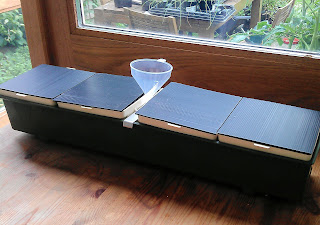Monday, August 10, 2015
Kitchen table hydroponics
 |
| Mixed salad seedlings growing hydroponically, without soil. |
Growing plants hydroponically, or without soil, is a clean, and resource-efficient way to successfully raise a variety of produce. Yet it seems to be viewed with a great deal of suspicion in many quarters. This extract, from Green Harvest, an Australian website, is reasonably typical:
"A large quantity of the salad greens available in the supermarket are grown hydroponically, the complete opposite of organically. Hydroponics is a growing system that bypasses the soil in favour of a 'nutrient soup' made from chemical fertilisers fed directly to the plants. The lettuces in the supermarket might look like a lettuce but chemical cocktail might be a better description."
I don't know what they put in bagged salad in Australian supermarkets, but I wonder what the author thinks soil consists of, if it's not a chemical cocktail itself.
Conventionally grown plants have their roots in soil, which is typically made up of minute rock particles, organic matter (material which was once living, now decayed) and water. The more fertile the soil, the more chemically rich it will be, especially in nitrogen, potassium, and phosphorus, the three main nutrients needed by plants.
However, the soil isn't necessary for plant growth; it's only there as the medium for delivering water and nutrients to the roots. Hydroponic growing eliminates the soil and concentrates on getting water and nutrients directly to the roots.
However, the soil isn't necessary for plant growth; it's only there as the medium for delivering water and nutrients to the roots. Hydroponic growing eliminates the soil and concentrates on getting water and nutrients directly to the roots.
What an organic philosophy and hydroponic growing have in common is the desire for sustainability. Both methods are far less fuel-intensive than using manufactured fertilisers. Organic systems aim to reduce soil erosion and exhaustion with the addition of organic matter; in many hydroponic systems, the growing medium can be reused many times. For example, perlite, the rock granules which are often used to anchor the roots, can be sterilised in a microwave and then used again for the next batch of hydroponically-grown seedlings. The micro-management that delivers precisely the nutrients needed to the growing plants also means there is far less waste.
If you look around on the Internet you'll find off-puttingly long lists of technical equipment required for a hydroponic set-up: pumps, filters, hoses, lights. You would be forgiven for thinking it's less like growing plants and more like a laboratory experiment.
However, much of the expensive and hi-tech kit is needed for hydroponic growing on an industrial or commercial scale. To successfully grow salad leaves an herbs on a windowsill, some pots, water and a soil-less growing medium is all you really need. And your 'nutrient soup' of course.
Hydroponics
+ Sustainable
+ Efficient use of resources - less waste
+ Takes up relatively little space, with high yields
+ Versatile – does not need fertile soil, can be grown anywhere
+ Cleaner to maintain
- Cannot be called organic
- Lot of management required to get the balance right
- Lot of management required to get the balance right
- Leaching if not managed properly
- Only suitable for some plants
We used a simple base kit from The Achiltibuie Garden. Based in the north-west highlands of Scotland, this company specialises in developing hydroponic growing systems for domestic use. Many of their systems are modular, so that you can add extra units to the base kit if your needs increase. This windowsill kit shown below, is good for raising salad cut-and-come-again leaves and herbs.
We used a simple base kit from The Achiltibuie Garden. Based in the north-west highlands of Scotland, this company specialises in developing hydroponic growing systems for domestic use. Many of their systems are modular, so that you can add extra units to the base kit if your needs increase. This windowsill kit shown below, is good for raising salad cut-and-come-again leaves and herbs.
 |
| The kit: long plastic trough and four pots. The growing medium, a mix of perlite and vermiculite, containers with liquid nutrients and four packets of seeds. |
 |
| The absorbent material which fits into the slotted base of each pot will take up water and the liquid nutrients into the pots. |
 |
| Once germinated the seedlings are covered with a strip of fleece to provide a protective 'micro-climate'. |
 |
| Topping up the water beneath each pot via the funnel. |
 |
| Our seedlings ten days after germination. From the bottom up: chervil, dill, salad mix and lamb's lettuce. |
We'll be discussing hydroponic growing in more detail in a future Secret Garden Workshop, looking at ways to set up a simple system in a restricted space and the most suitable plants for this kind of set-up. Keep an eye on our Events pages for scheduled dates.
http://ag.arizona.edu/hydroponictomatoes/overview.htm
Highly detailed discussion of hydroponic tomato growing, including a history of hydroponic development.
http://www.theecologist.org/News/news_analysis/269753/hydroponics_in_the_city.html
Highly detailed discussion of hydroponic tomato growing, including a history of hydroponic development.
http://www.theecologist.org/News/news_analysis/269753/hydroponics_in_the_city.html
Sustainability of hydroponics, roof top gardening, using excess heat from air-conditioning units
The Achiltibuie Garden website, addressing issues of sustainability
Labels:
chervil,
dill,
growing medium,
Herbs,
Hydroponics,
nutrients,
perlite,
salad,
sustainable,
vermiculite
Subscribe to:
Post Comments (Atom)




No comments:
Post a Comment